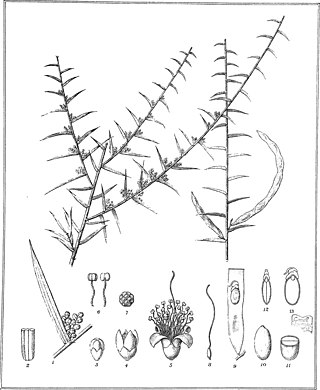
Homoranthus is a genus of about thirty species of plants in the myrtle family Myrtaceae and all are endemic to Australia. Plants in this genus share similarities with those in both Darwinia and Verticordia. They are shrubs with their leaves arranged in opposite pairs and with flowers appearing either singly or in small groups, usually in upper leaf axils. They are found in Queensland, New South Wales and South Australia. The genus was first described in 1836. None of the species is common nor are they well-known in horticulture.

Acacia retinodes is an evergreen shrub that is native to South Australia, Victoria and Tasmania. Short racemes of yellow flowers are produced periodically throughout the year. Some common names are Retinodes water wattle, swamp wattle, wirilda, ever-blooming wattle and silver wattle.

Acacia glaucoptera, commonly known as flat wattle or clay wattle, is a species of Acacia which is endemic to the south-west of Western Australia.

Acacia bynoeana, known colloquially as Bynoe's wattle or tiny wattle, is a species of Acacia native to eastern Australia. It is listed as endangered in New South Wales and as vulnerable according to the Environment Protection and Biodiversity Conservation Act 1999.

Acacia crispula is a shrub belonging to the genus Acacia and the subgenus Phyllodineae that is native to southern parts of Western Australia.
Acacia erioclada is a shrub belonging to the genus Acacia and the subgenus Phyllodineae native to Western Australia.

Acacia gonophylla, also known as rasp-stemmed wattle, is a shrub belonging to the genus Acacia and the subgenus Phyllodineae that is endemic to south western parts of Australia.

Acacia iteaphylla, commonly known as Flinders Range wattle, Port Lincoln wattle, winter wattle and willow-leaved wattle, is a shrub belonging to the genus Acacia and the subgenus Phyllodineae that is endemic to South Australia.

Acacia leptopetala is a shrub belonging to the genus Acacia and the subgenus Phyllodineae that is endemic to an area of south western Australia.

Acacia leptospermoides is a shrub belonging to the genus Acacia and the subgenus Phyllodineae and is endemic to a large area of south western Australia.

Acacia dura is a shrub of the genus Acacia and the subgenus Plurinerves that is endemic to south western Australia.

Acacia loxophylla is a shrub of the genus Acacia and the subgenus Plurinerves that is endemic to an area of south western Australia.

Acacia setulifera is a shrub of the genus Acacia and the subgenus Plurinerves that is endemic to an area of northern Australia.

Acacia dictyocarpa is a shrub belonging to the genus Acacia and the subgenus Phyllodineae that is endemic to south eastern Australia.

Acacia nematophylla, commonly known as coast wallowa, is a shrub belonging to the genus Acacia and the subgenus Phyllodineae where it is endemic to southern Australia.

Acacia rhigiophylla, commonly known as dagger-leaf wattle, is a shrub belonging to the genus Acacia and the subgenus Juliflorae that is native to southern Australia.

Olearia muelleri, commonly known as Mueller daisy bush, Mueller's daisy bush or Goldfields daisy, is a species of flowering plant in the family Asteraceae and is endemic to southern continental Australia. It is a compact or spreading shrub with scattered spatula-shaped to egg-shaped leaves with the narrower end towards the base, and white and yellow, daisy-like inflorescences.
Pomaderris flabellaris, commonly known as fan pomaderris, is a species of flowering plant in the family Rhamnaceae and is endemic to South Australia. It is a low shrub with fan-shaped leaves, and small clusters of woolly-hairy flowers.
Olearia hookeri, commonly known as crimsontip daisybush, is a species of flowering plant in the family Asteraceae and is endemic to Tasmania. It is a sticky shrub with small, narrowly linear leaves and white to bluish-purple and yellow, daisy-like inflorescences.
Olearia picridifolia, commonly known as rasp scrub-daisy, is a species of flowering plant in the family Asteraceae and is endemic to southern continental Australia. It is a low, spreading shrub with narrowly egg-shaped or narrowly elliptic leaves, and blue, mauve or white and yellow, daisy-like inflorescences.















